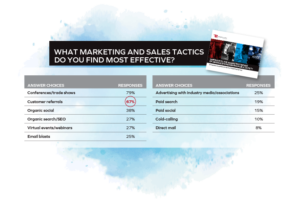
You know that Zoom meeting you had last Thursday where four people were talking at once and you couldn’t understand any of them? That’s sort of what it’s like when you try to communicate too much about a product or tell your whole marketing story with every product or service you offer.
We get it. It happens. We see it often with our clients: You’re excited about your brand and have a new product you want to tell the world about. You have a lot to say about its attributes, benefits and differentiators—maybe across a number of product lines. But overcommunicating, or communicating inconsistently, gives both current and prospective customers a lot to take in. Often too much.
Here are a few strategies to ensure you’re unifying what you offer under a single messaging strategy and tying everything back to your core brand principles:
Get your house in order.
It probably goes without saying that if operations, sales, marketing, engineering, and leadership are all communicating differently about your products, the result is likely to be confusion. RedFlash Group has worked with a number of clients to bring internal teams into alignment on not just what a company’s value proposition is, but the features and capabilities of specific products and categories to adopt shared terminology for names, benefits, characteristics and more.
Bake in the marketing.
Think of this tip as Part II of getting your marketing house in order. In short, make sure you don’t simply tack on marketing considerations at the end of the product development process. Marketing and sales should have a seat at the table from the start—as early as when the product or software team sits down to concept a new idea. Doing so helps ensure that all-important alignment is in place right away, reducing the chances that different (even contradictory) messaging will crop up later.
Try a messaging pyramid.
One technique we like to use is mocking up a simple visual that highlights the specific messages you’ll use to talk about your company and what it produces. Using a pyramid model, the very top is your company’s mission, its primary goal, such as keeping firefighters safe. The next level down in the pyramid is the benefit for your customers at the highest level. In this case, let’s say it’s clothing that protects firefighters against chemical fires. The third level—the base of the pyramid—is where you articulate how, exactly, you do this. In the chemical-resistant clothing example, perhaps it’s that you use state-of-the-art techniques to make unique PPE for firefighters.
You can see from this exercise that your product marketing should always tie back to your overarching vision at the top. This is your best chance to position yourself accurately and effectively in the marketplace. Every piece of your product line should be clear and consistent in the value it brings to your target audience(s), why you exist and what differentiates you from your competition.
As your company or a product line grows, be sure to leverage the strengths of your brand with any new “offspring” products. It can be hard to resist the temptation to refer to new offerings as different, but that risks undermining the power of unified messaging. Without the weight of an established brand behind a new entry to the market, you might cause confusion and even lose credibility.
Think benefit, not function.
Too often, companies name a product something that relates to what the thing does, rather than homing in on the problem it solves for customers. Think Mission Control XT21, as compared to the much more straightforward 911 Call Management Suite.
We don’t mean to imply that evocative approaches to naming products are off the table. But whether a solution you’re offering is functional or conceptual, it should have clear meaning beyond the four walls of your company. A name that corresponds to an internal shorthand only you and your engineers will immediately get is risky at best.
As the marketing team, it’s important to be part of the naming process early on and to be intentional, too, about organizing the hierarchy of your products (more on that below).
Escape the matrix.
One client we worked with—let’s call them AZ Tech, Inc.—made dozens of products, but there was no real hierarchy to help potential customers find what they needed or to understand how different products related to each other. It wasn’t uncommon for someone to ask questions like, “If I buy your GIS product, will it also include your app ecosystem? Or do I need to get that as an add-on?” Their site was essentially a tangled web of everything they made, with few clear cues for users to help them match a product to their need.
We first worked with AZ Tech to create a massive matrix of all the products they made, identifying the benefit(s) for each, who it was for and how it was packaged and sold. From there, we helped them rename products to make sure customers knew these potentially disparate products and features all, in fact, came from the same company—one their customers were likely to know and trust.
Then we developed messaging that clarified which products were core elements that all customers would need to start with and which were modules with other features they could buy to customize their suite of products as they wanted. Our work also ensured that every element of what the company makes connected back to their overarching claim—that statement at the top of the pyramid.
We want to stress that AZ Tech is far from alone. Many companies are simply so close to their work that they develop a myopia that prevents them from seeing their messaging as an outsider would. In short, remember that your customers don’t need to know everything about every product or everything about your brand. Be judicious in what you share and how you do so and check to be sure all roads lead to back to your mission, your place in the market and the value only you can bring.
If you’d like to talk about how to develop clear messaging about your products or services, we’d love to talk.






 The RedFlash Group is a GSA Contract Holder under Schedule 541, Advertising and Integrated Marketing Solutions
The RedFlash Group is a GSA Contract Holder under Schedule 541, Advertising and Integrated Marketing Solutions